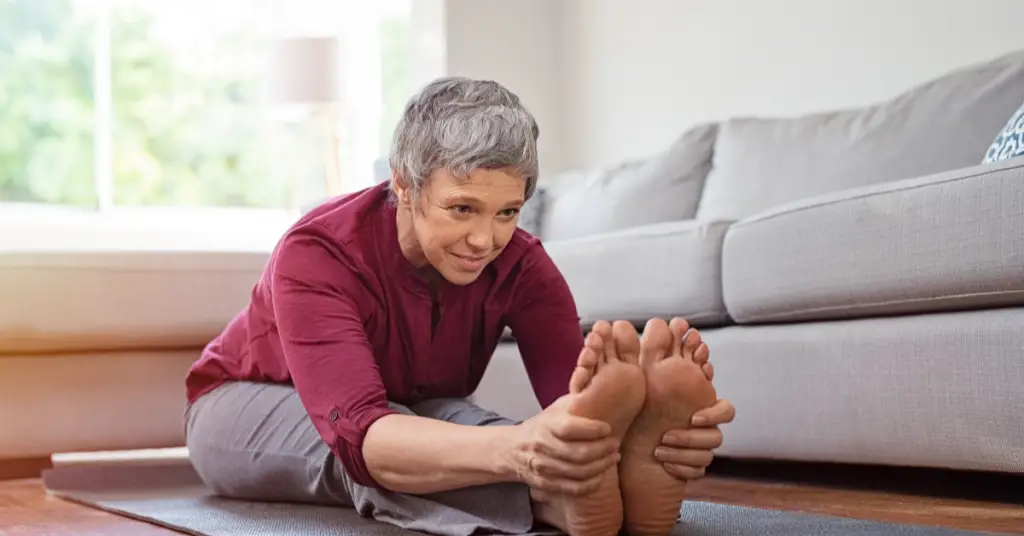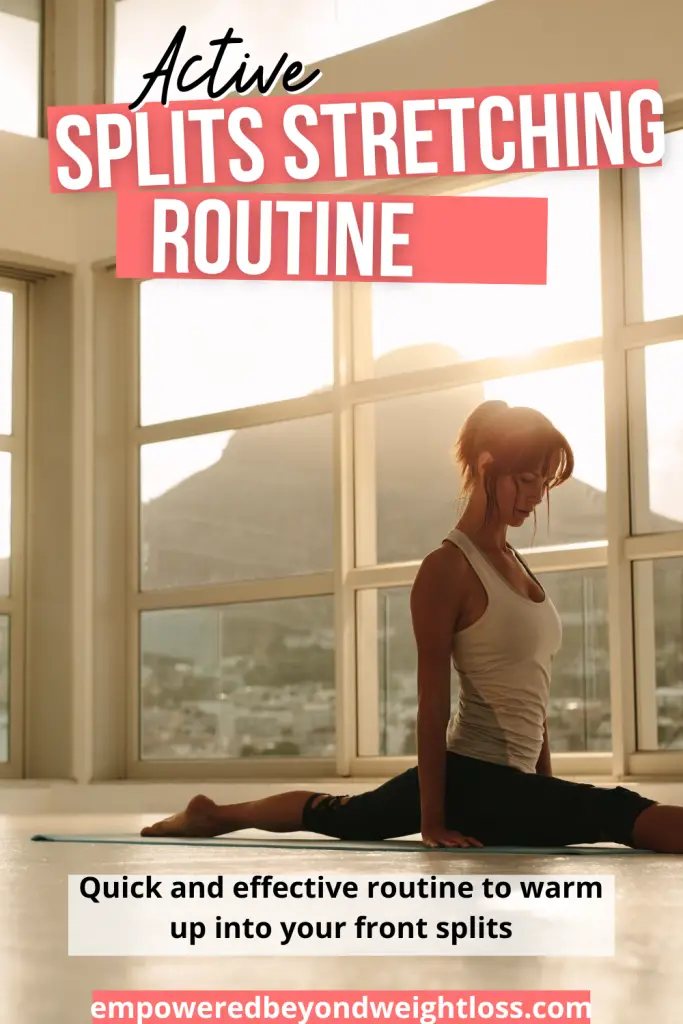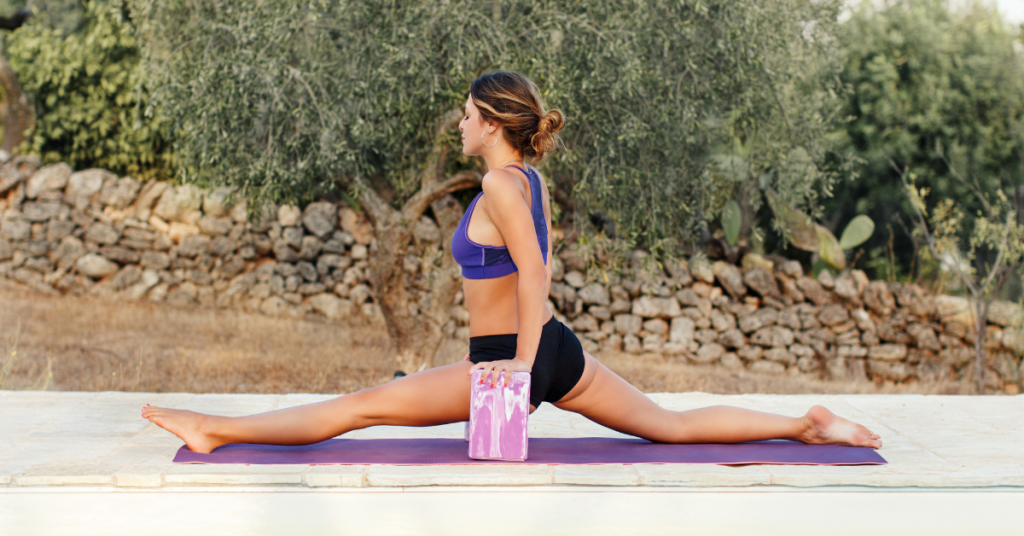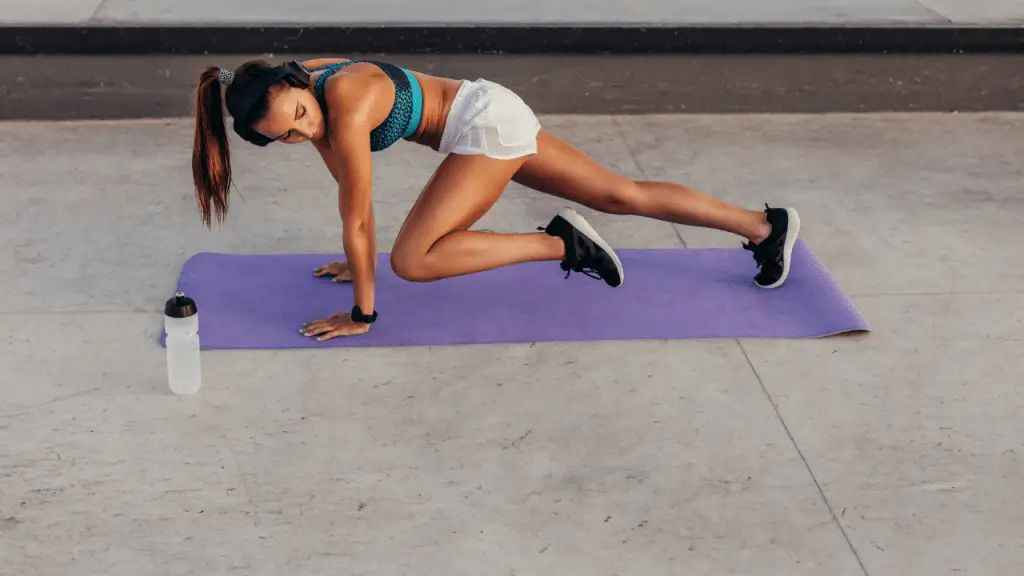I recommend a lot of passive stretching when learning the spits over 40. However, this active splits stretching routine is helpful whenever you want to refine your front splits (say, you can sit on blocks and are struggling with advancing to a more comfortable split and keeping your hip squared). Furthermore, you will learn that passive stretching isn’t necessarily “passive.”
Active Splits Stretching Full-Length Routine
This routine includes my favorite active splits stretches to increase your strength and flexibility.
What Is Active Stretching?
Active stretching is a type of flexibility exercise in which you use the muscles opposing the ones you want to stretch to facilitate the stretch. It involves actively contracting the muscles opposite to the ones you are trying to lengthen. This can help improve your flexibility and range of motion.
Here’s how active stretching works:
- Muscle Contraction: You start by contracting the muscle group that opposes the one you want to stretch. For example, if you want to stretch your hamstrings (the muscles at the back of your thighs), you would actively contract your quadriceps (the muscles at the front of your thighs).
- Hold and Release: You hold this contraction for a few seconds, typically 5-10 seconds. This is often referred to as the “hold” phase.
- Relax and Stretch: After holding the contraction, you release and relax the opposing muscles while simultaneously trying to stretch the target muscles gently. In the case of hamstring stretching, you would relax your quadriceps and try to extend your hamstrings by moving your leg gently.
- Repeat: You can repeat this process for a few cycles, gradually working to increase the stretch each time.
Active stretching allows you to have more control over the stretching process and reduces the risk of overstretching or injury. It’s commonly used in warm-up routines before physical activities or as part of a regular flexibility training regimen.

Active Stretching Vs. PNF
- Active Stretching: In active stretching, you use the muscles opposing the ones you want to stretch to facilitate the stretch. You actively contract the opposing muscles to encourage the target muscles to relax and lengthen. Active stretching relies primarily on your muscle strength and control.
- PNF Stretching: PNF stretching involves a combination of muscle contraction and relaxation. It typically includes three phases: a passive stretch (a partner or prop may assist in stretching), an isometric contraction (holding the stretch against resistance), and another passive stretch. PNF stretching often requires a partner or therapist to assist with the stretches.
Active Stretching Examples
Here are some examples of active stretching exercises for different muscle groups:
- Standing Quadriceps Active Stretch:
- Stand on one leg.
- Bend your knee and bring your heel towards your buttocks.
- Hold your ankle with your hand.
- Contract your hamstrings (the muscles at the back of your thigh) by attempting to push your foot against your hand.
- Hold for a few seconds and then release, trying to bring your heel closer to your buttocks.
- Repeat on the other leg
- Calf Active Stretch:
- Stand with one foot in front of the other.
- Bend your front knee while keeping your back leg straight.
- Contract your calf muscles in the back leg by pushing your heel into the floor.
- Hold for a few seconds and then release to deepen the stretch.
- Switch to the other leg.
- Hip Flexor Active Stretch:
- Kneel on one knee with the other foot in front.
- Contract your glutes by pushing your hips forward slightly.
- Hold for a few seconds and then release, feeling the stretch in the front of your hip.
- Switch to the other leg.
Even though I recommend passive stretching over active stretching, I would venture to say that my passive stretches are mostly active. As you saw me explain in the short video above, I tend to engage the opposing muscles whenever I stretch.

Active Splits Stretching for Beginners
As you may know, I recommend primarily passive stretching for beginners. Passive stretching trains your nervous system, and beginners need to ensure they spend enough time in each posture to train their brains that it is safe. However, it can be helpful to experiment and mix things up.
Active stretching can be beneficial for beginners looking to gradually and safely improve flexibility. Here’s how active stretching can help beginners become more flexible:
- Increased Muscle Control and Awareness: Active stretching encourages beginners to become more aware of their muscles and how they function. By actively contracting and relaxing opposing muscle groups, beginners better understand their body’s mechanics.
- Reduced Risk of Injury: Active stretching allows beginners greater control over their movements. This reduces the risk of overstretching or straining muscles, which is particularly important for those new to flexibility training.
- Improved Range of Motion: Regular practice of active stretching can gradually increase a beginner’s range of motion. By actively engaging the muscles while stretching, they can lengthen the muscle fibers over time, improving flexibility.
- Enhanced Joint Mobility: Active stretching often involves moving joints through their full range of motion, which can lead to improved joint mobility. This is especially beneficial for beginners who may have stiff or tight joints.
- Better Warm-Up Routine: Active stretching can warm up before other physical activities or workouts. It helps increase blood flow to the muscles, preparing them for more intense exercise and reducing the risk of injury.
- Builds Foundation: Active stretching is a foundation for more advanced flexibility training techniques, such as passive or PNF stretching. As beginners become more comfortable with active stretching, they can use other methods to enhance their flexibility.

Active Splits Stretching Protocol
I recommend focusing on my passive front splits stretches until you can sit on yoga blocks in the splits. Here are some of my front-split routines for beginners:
- How to Stretch to Do the Splits
- How to Increase Your Flexibility for the Splits
- Learning the Splits Over 40: Can Anyone Learn the Splits?
Once you are ready to refine your form and deepen your splits practice, include more active splits stretching.
Active Splits Stretching Examples
Some of my favorite active split stretches are the standing split with pistol squat and the active low lunge with the half splits. You will see all of them in today’s follow-along routine, but here’s a quick description of these active stretches. You will find them in today’s full-length routine.
In Summary
In conclusion, incorporating both passive and active stretching into your routine can provide a long-term solution for improving flexibility. By consistently practicing these techniques, you can achieve a greater range of motion and overall body flexibility. Remember, consistency is key on your journey towards increased flexibility. I invite you to join my 5-Day Yoga Habit Challenge to kickstart your progress. Take the first step towards a more flexible and healthy lifestyle today.





